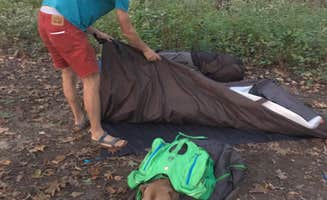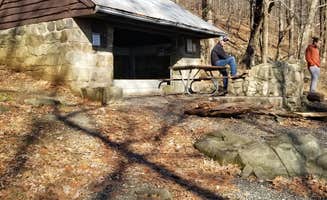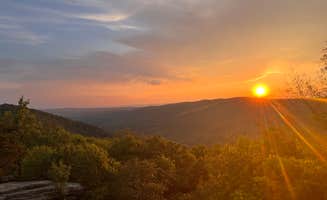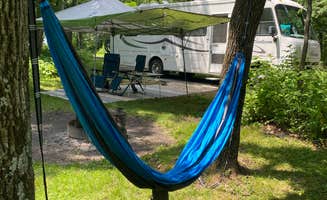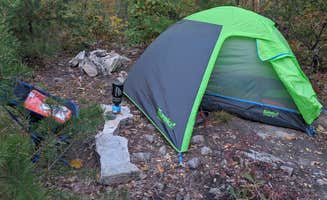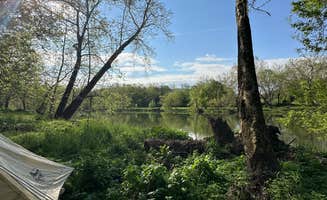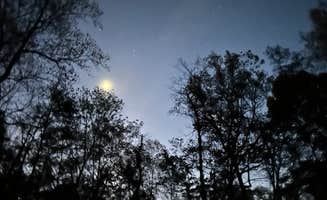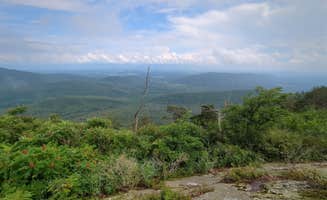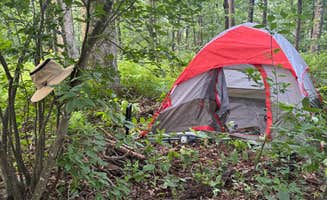Rustic camping near Delaplane, Virginia offers primarily elevation-based experiences with sites ranging from 1,200 to 3,000 feet above sea level across the region's Blue Ridge terrain. The George Washington National Forest and Shenandoah National Park create a connected wilderness corridor with distinct camping regulations on either side of the boundary. Most dispersed sites become inaccessible November through March due to seasonal forest road closures.
What to do
Creek exploration: Multiple primitive sites at South Fork Shenandoah River provide direct water access for fishing and swimming. As one camper noted, "Our site was amazing! Not too many spaces so it can fill up quick. There is a launch in the middle, so there is a bit of come and go."
Ridge hiking: For elevation gains and valley views, the 4-mile uphill trail to Veach Gap - GWNF - Backpacking Site delivers ridgeline camping with panoramic vistas. "Breathtaking views of the Shenandoah River and surrounding mountains. Very much worth the 4 mile hike up to the site. 1,200ft elevation difference from the trailhead to the site," reports one backpacker.
Wildlife observation: Dawn and dusk provide optimal wildlife viewing hours at most backcountry sites. Campsites along quieter trails frequently report deer sightings, and black bears remain active throughout the region. A visitor to the area mentioned, "2 deers came to visit us at night. Killed a cottonmouth buried it since I didnt know how to properly cook and eat it. Saw Momma and two baby black bears."
What campers like
Established fire rings: Despite fire restrictions in many parts of Shenandoah National Park, George Washington National Forest allows campfires at designated sites. At Little Fort Campground, "You select a campsite by flipping a washer on a hook on the board from green to red. Flip it back when you leave. The campsites have a fire ring, a picnic table, and a flat area to pitch a tent."
Cell service gaps: Many campers appreciate the forced disconnection at most primitive sites. Reception varies dramatically by location and carrier. One camper reported about Veach Gap, "Cell service at the top (not during the hike or on the road to the trailhead so prepare directions)," while another noted at South Fork, "Verizon gets no service whatsoever not even the hotspot."
Spacious sites: Unlike developed campgrounds, dispersed camping often provides greater distance between neighbors. At Wolf Gap Recreation Area, "Most sites have a paved parking platform and then a second tier for the camp site. All sites are quite large and include picnic tables, fire rings and large tent platforms."
What you should know
Water planning requirements: Many ridge sites lack reliable water sources, requiring hikers to carry all needed water. As one Veach Gap camper advised, "It is about 4 miles up, so not too bad, but there is no water after the first mile. I have seen a small trickle part way up the mountain, but don't count on it. Pack up all the water you will need for the day/evening/morning."
Seasonal flooding: Low-elevation riverside camping becomes unusable after heavy rain events. A South Fork Shenandoah camper shared, "I went back early October to possibly camp again, shortly after the hurricane rains had passed. The sites were underwater or filled with river mud, making them completely un-campable."
Weekend congestion: Sites without reservation systems fill quickly Friday afternoons. A visitor to Crisman Hollow Road Camp observed it as "a quiet area with many spots right on the water," but noted that accessibility can be limited as "some roads were closed. Some spots were full of trash."
Tips for camping with families
Trail difficulty planning: When bringing children, carefully assess elevation gain requirements. The Veach Gap trail rises 1,200 feet over 4 miles, making it challenging for young hikers but manageable for older children with backpacking experience.
Tent platform availability: Several dispersed sites feature built wooden platforms that keep sleeping areas drier during wet conditions. At Wolf Gap, sites include "large tent platforms" that provide flat, stable surfaces for family-sized tents.
Bug preparation: Insects present challenges at most river sites from May through September. A Compton Gap Backcountry camping visitor reported their site was "Buggy and damp. Not our favorite campground. If you're a through hiker, it'll get the job done though."
Tips from RVers
Road access limitations: Most dispersed camping near Delaplane restricts access to high-clearance vehicles. At Squirrel Hollow Road Camping, "Sites are located less than a mile from the paved highway. We found 5 spots just off the road. All were easily accessible by car or with a small teardrop trailer."
Leveling challenges: Even designated dispersed sites rarely offer level parking. One RVer noted, "Many of the car parking pads are not level. But the tent pads appear to be."
Weekend traffic patterns: Weekday camping provides significantly more solitude for RV campers. A Squirrel Hollow Road visitor observed, "We camped during the week and had nobody else camping on weekdays," and noted it "looks like a popular weekend camp spot for locals."


